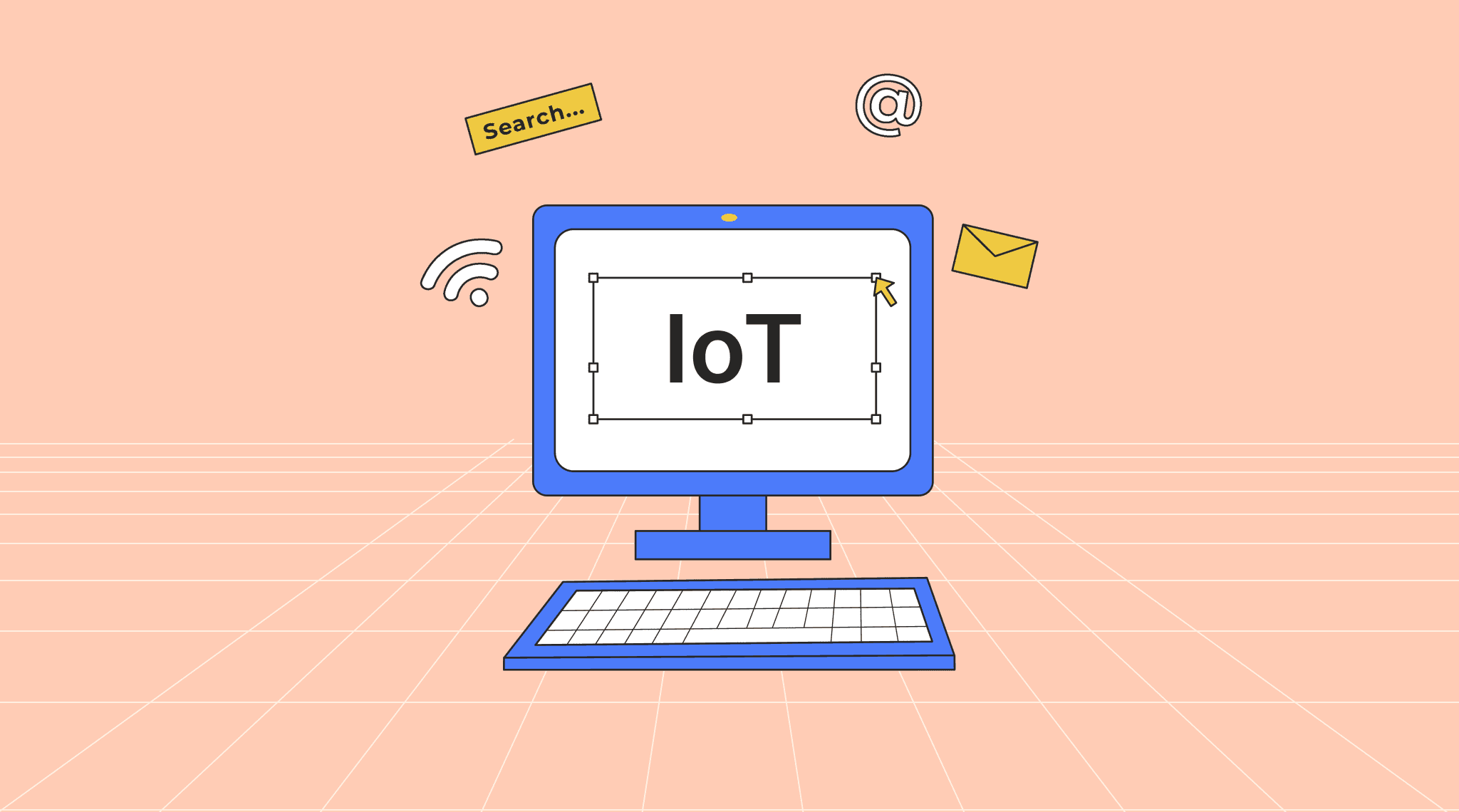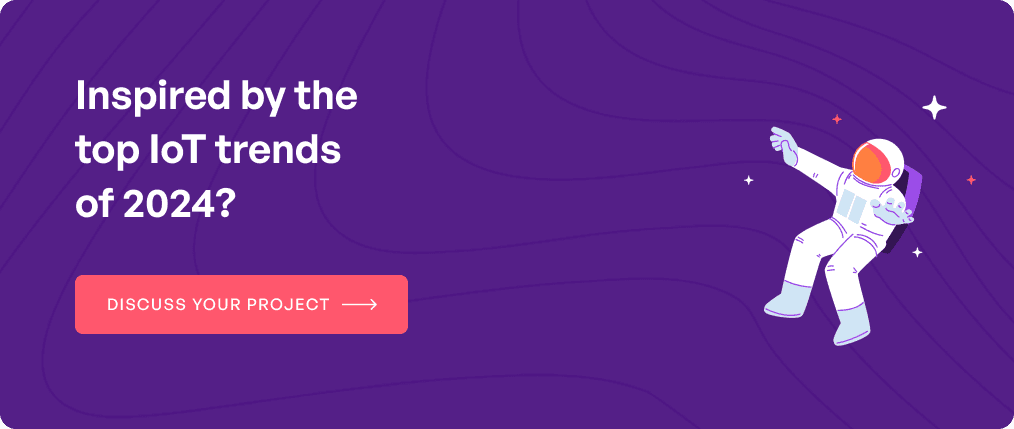Do you know what the future holds for IoT in 2024 and beyond? AI and data are hot topics of the digital world in the current times but don’t underestimate the importance of the Internet of Things as it is becoming crucial to move towards a limitless future. From enhancing machine learning capabilities to transforming daily interactions, IoT is at the heart of modern technological progress.
As we navigate through 2024, businesses must keep a keen eye on emerging trends in IoT. Creativity in utilizing evolving technologies is key to staying ahead in the market. With the latest IoT technology paving the way for seamless connectivity and data exchange, there are plentiful opportunities for innovation that are yet to be explored.
Step into the future where IoT isn’t just a word in the tech industry but a dynamic force shaping our lives. From everyday objects to industrial machinery, IoT’s influence knows no bounds. As we are welcoming the possibilities of interconnected devices, the journey towards a smarter, more connected world evolves in front of our eyes.
Table of contents
Current IoT Trends Market Stats
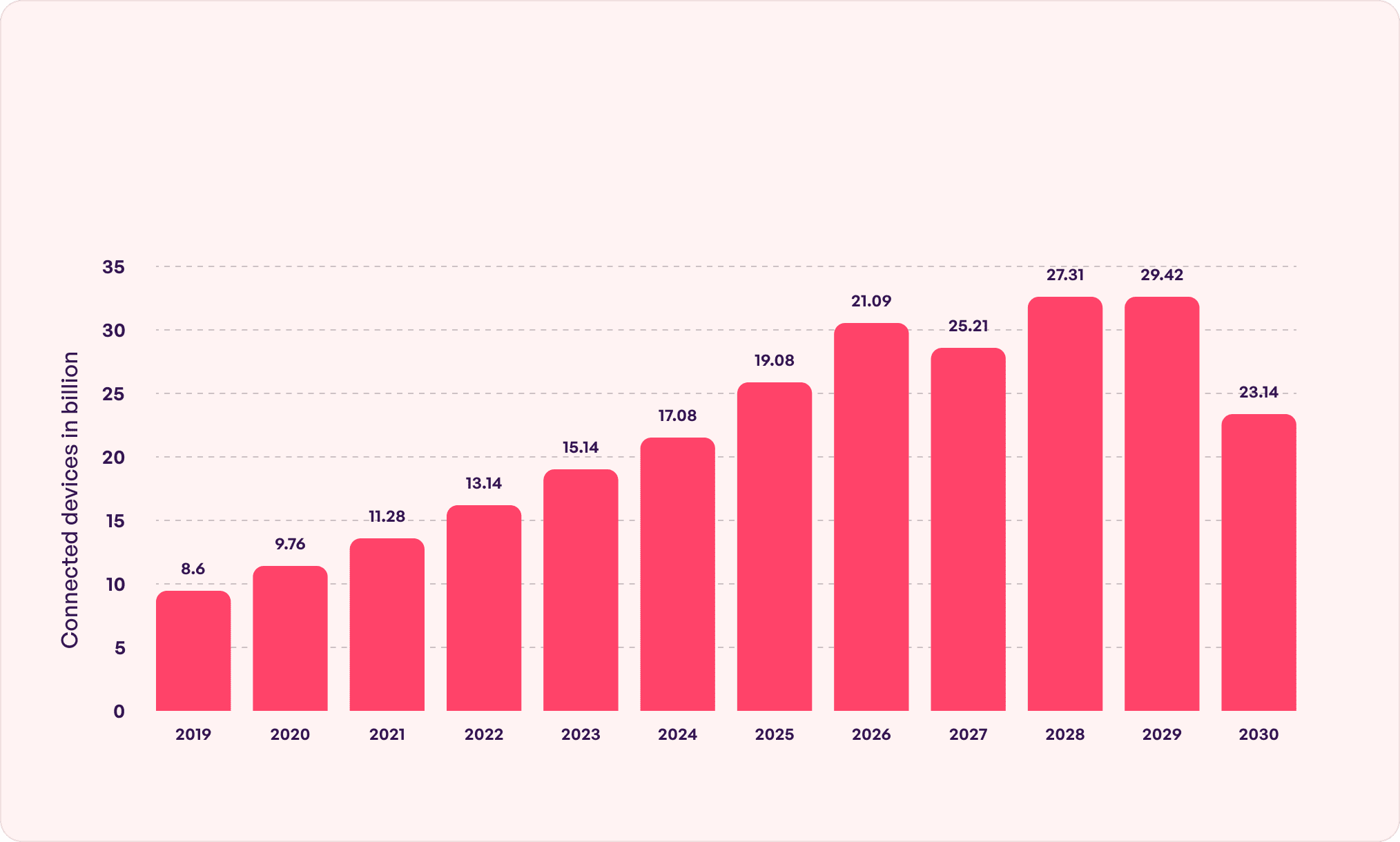 Think of IoT as the driving force behind industries like healthcare, transportation, retail, and manufacturing. It’s reshaping them in ways we’ve never imagined. Let’s dive into the numbers and estimates that paint a vivid picture of this dynamic landscape:
Think of IoT as the driving force behind industries like healthcare, transportation, retail, and manufacturing. It’s reshaping them in ways we’ve never imagined. Let’s dive into the numbers and estimates that paint a vivid picture of this dynamic landscape:
- By 2030, the global IoT market is forecasted to soar to $3,352.97 billion, with a staggering CAGR of 26.1%.
- According to Mordor Intelligence, the global IoT market trend is expected to reach a valuation of $1.39 trillion by 2026, signaling its rapid growth trajectory.
- By 2030, an estimated 29 billion IoT devices are expected to be interconnected worldwide, showcasing the exponential expansion of IoT connectivity.
- Currently, there are over 400 active IoT platforms, with the top 10 commanding around 65% of the market share.
- The U.S. IoT market was valued at $45.7 billion in 2020, and China’s IoT market is projected to reach $169.1 billion by 2027, reflecting a robust CAGR of 29.9%.
Across industries and geographies, the enthusiasm for IoT adoption is noticeable, with 85% of enterprise IoT decision-makers already engaged in various stages of IoT projects.
Why IoT Technology is Becoming so Pervasive?
The extensive nature of IoT technology is derived from various factors that have fueled its widespread adoption and integration into diverse sectors.
IoT gadgets are designed to effortlessly connect to the internet while letting them chat with each other and access online services with ease. This connectivity opens doors to a multitude of applications, spanning from smart homes to industrial automation, promoting efficiency and innovation.
Moreover, the declining costs of IoT devices have balanced their access, making them more attainable for consumers and businesses alike. This affordability surge has propelled increased adoption and the emergence of novel use cases, from home automation gadgets to complicated industrial sensors.
Crucially, IoT’s ability to generate ample amounts of data stands as a pillar of its dominance. This data rush fuels insightful analytics, empowering businesses to extract valuable insights into consumer behavior and operational processes, driving enhanced efficiency and productivity across industries.
Top Electrifying IoT Trends of 2024 and Beyond
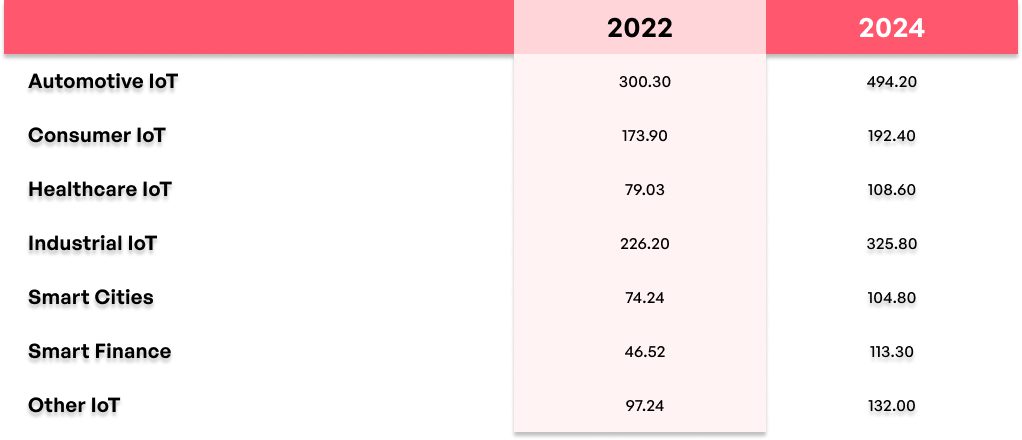 Comparing the market size by sector in 2022 and 2024 in Bn dollars
Comparing the market size by sector in 2022 and 2024 in Bn dollars
Get ready to dive into the electrifying world of IoT as we reveal the top technology trends in IoT shaping 2024 and beyond. From advancements in AI integration to the rise of edge computing, these trends promise to revolutionize the IoT landscape, driving innovation and transforming industries. Stay tuned for an insightful exploration of the future of IoT solutions.
1. AI and ML Integration to Enable Intelligent IoT Systems
In 2024 and beyond, the fusion of AI and ML with IoT is set to redefine the landscape of technology. This integration paves the way for intelligent IoT systems that adapt and evolve based on their surroundings. AI’s ability to process vast amounts of data and ML’s self-improving algorithms make IoT applications more efficient and effective. From predictive maintenance to energy management, these advancements promise solutions that optimize operations and drive innovation across industries.
Imagine self-driving cars predicting traffic patterns, smart home devices adjusting to user preferences, and automated robots efficiently managing warehouse inventory. With AI and ML at command, the possibilities for intelligent IoT applications are limitless, offering businesses a competitive edge and users seamless experiences in the digital arena.
2. 5G Connectivity Will Drive IoT Growth
The arrival of 5G connectivity promises a new era of IoT growth and innovation. With its lightning-fast speeds and minimal latency, 5G surpasses its predecessor, 4G, empowering a multitude of IoT applications. From real-time robotics to disaster recovery equipment, the possibilities for 5G-enabled IoT devices are endless.
Forecasted as one of the top IoT trends of 2024, the expansion of 5G networks fuels breakthroughs in smart city technologies, autonomous vehicles, and immersive experiences like virtual and augmented reality. As 5G networks expand, the possibilities for IoT innovation are boundless, promising to enhance efficiency, reliability, and connectivity on a global scale. Get ready to witness the electrifying impact of 5G as it energies the evolution of IoT technologies in 2024 and beyond.
3. Blockchain will Enhance IoT Security
Blockchain is assured to revolutionize IoT security, emerging as a critical trend in 2024 and beyond. By balancing data storage and transmission, Blockchain ensures tamper-proof records, boosting trust and integrity across IoT networks. This technology enables precise tracking of product journeys, enhancing transparency and accountability in global supply chains.
As businesses increasingly rely on IoT devices to handle sensitive data, the integration of Blockchain safeguards against unauthorized access and manipulation. With its transparent and immutable ledger, Blockchain offers a robust framework for securing interconnected devices, paving the way for a future where trust and security are paramount. As the global blockchain IoT market trends continue to expand, the synergy between Blockchain and IoT indicates a new era of innovation and reliability.
4. Edge Computing will Improve Performance
Edge computing emerges as a game-changer in the IoT world, promising enhanced performance and efficiency. By processing data closer to its source, edge networks reduce latency and ensure faster response times. This decentralized approach not only improves offline operation but also enhances data privacy and security, critical factors in today’s interconnected world.
Furthermore, edge computing optimizes bandwidth usage by filtering and compressing data locally, minimizing the strain on network resources. As IoT applications demand real-time processing and seamless connectivity, the adoption of edge computing becomes critical, enabling businesses to stay agile and competitive in the evolving digital landscape.
5. Wearables will Keep Track of Health Records
In 2024, the rise of the latest IoT technology like wearables promises a transformative impact on healthcare. From fitness trackers to smartwatches, these devices offer innovative ways to monitor health records and stay connected. With advancements in generative AI, wearable devices and gadgets now dynamically generate personalized insights, enhancing the user experience and facilitating real-time health monitoring.
As wearables become active companions, they play a pivotal role in revolutionizing medical care, enabling remote patient monitoring and continuous health record tracking. The fusion of IoT and wearable technology marks a significant jump forward in healthcare, empowering both patients and healthcare providers with actionable data and insights.
6. Smart Cities to Improve Resident Facilities
The concept of smart cities is on the rise these days, offering innovative solutions to urban challenges. Through IoT technologies, cities can monitor traffic, detect flooding, and manage energy usage more efficiently. Smart streetlights, equipped with sensors, serve multiple purposes, from detecting weather conditions to hosting public Wi-Fi, enhancing safety and convenience for residents.
As urbanization continues, the integration of IoT solutions becomes crucial for improving efficiency and sustainability. By utilizing real-time data, smart cities can optimize resource allocation and implement responsive policies, ultimately enhancing the quality of life for residents. With the potential to reduce casualties and improve safety, smart cities represent the future of urban development.
7. Voice-activated IoT Devices for Quick Replies
In 2024, the integration of voice assistants like Alexa and Google Assistant with IoT devices will redefine convenience and accessibility. With simple voice commands, users can effortlessly control their smart devices, from adjusting home settings to managing productivity tools. This flawless interaction opens doors to innovative applications across various industries, revolutionizing how we interact with technology.
Voice recognition technology when combined with AI-powered virtual assistants, offers hands-free operation and increased efficiency. From smart homes to industrial settings, voice-activated IoT devices streamline tasks and enhance user experience, paving the way for a more intuitive and interconnected future.
8. Increased Focus on Data Privacy and Security
Ensuring data privacy and security in the IoT landscape is crucial, especially with the surge in interconnected devices. With cyber threats evolving, safeguarding sensitive information becomes vital. Businesses must invest in robust cybersecurity measures, utilizing technologies like AI and blockchain, to secure their networks and protect against potential breaches.
As the IoT ecosystem expands, industries like healthcare face heightened risks due to the vast amount of data exchanged. Implementing strict security protocols and complying with regulatory standards are essential to maintain trust and integrity. With the IoT security market booming, businesses must stay watchful and proactive in addressing emerging threats to uphold data privacy and safeguard against cyber attacks.
9. Greater Efficiency and Personalization in Customer Service
In the customer service world, IoT promises greater efficiency and personalized experiences. By harnessing the power of IoT and Big Data, businesses can customize services to individual preferences, ensuring a seamless and customized interaction for each customer. This convergence of technologies clears the way for true omni-channel customer experiences, fulfilling the evolving needs of modern-day consumers across various industries. With IoT-enabled solutions, businesses can foretell customer needs proactively, delivering timely and relevant assistance to enhance satisfaction and loyalty.
10. Beyond Automation: IoT AI Applications Redefining Corporate Innovation
The synergy between Artificial Intelligence (AI) and the Internet of Things (IoT) is reshaping corporate solutions. With an expected 64 billion IoT devices by 2025, the fusion of AI and IoT technologies is revolutionizing traditional industrial practices. AI algorithms, requiring minimal data, now power intelligent machines, automating tasks and enabling autonomous decision-making.
This combination not only streamlines processes but also enhances productivity, reduces operating costs, and facilitates predictive maintenance, assisting in an era of efficiency and innovation across industries. Through IoT-powered AI applications, businesses can unlock new levels of optimization and performance, driving forward into a future of smart, interconnected solutions.
11. Clearing the Roads: How Smart Traffic Management Cuts Congestion
In bustling cities worldwide, traffic congestion poses a significant challenge, leading to wasted time and decreased productivity. However, with the emergence of IoT technology, innovative solutions are reshaping traffic management systems, promising to alleviate unnecessary congestion. By leveraging IoT-installed technology in both traffic systems and vehicles, smart traffic networks are being developed to optimize traffic flow and reduce gridlock.
Integrating IoT into traffic management holds the promise of transforming urban mobility, thereby enhancing economic productivity, and improving the overall quality of life for city residents. Through strategic implementation and collaboration, IoT-driven traffic management systems have the power to revolutionize urban transportation, paving the way for a more sustainable and efficient future.
12. Digital Twins for Monitoring and Controlling Asset Utilization
Digital twin technology, a standout trend since 2020, offers a virtual replica of physical objects or processes. It enables real-time monitoring and control of asset performance and utilization, revolutionizing various industries. This virtual counterpart facilitates thorough testing and optimization before real-world implementation, saving resources and enhancing efficiency. With projected market growth, digital twins are poised to reshape industries like manufacturing, automotive, and healthcare, offering opportunities for predictive maintenance and process optimization.
The global digital twin market is on a rapid upward trajectory, driven by its integration with IoT, AI, and data analytics. As interconnected systems generate vast amounts of data, digital twins empower optimization and scenario planning, unlocking new possibilities for innovation and efficiency across sectors.
13. The integration of IoT and Metaverse will Create New Prospects for Expansion
The integration of IoT with the Metaverse holds immense potential for reshaping the tech landscape. By leveraging IoT’s capabilities within the Metaverse framework, new opportunities for growth and expansion emerge across various industries. From gaming and entertainment to retail, manufacturing, and beyond, the Metaverse’s application spans diverse sectors, promising innovation and advancement on a scale previously unseen.
As the Metaverse continues to evolve and associated with IoT technology, the possibilities for immersive experiences, enhanced connectivity, and innovative solutions are boundless. This combination opens doors to a future where virtual and physical worlds seamlessly blend, unlocking new frontiers for exploration and creativity.
Industry Wise IoT Applications
In this ever-evolving world of tech, IoT (Internet of Things) is revolutionizing how industries operate. From smart manufacturing to healthcare and agriculture, IoT applications are enhancing efficiency, reducing costs, and improving decision-making processes. As the demand for connected devices continues to rise worldwide, the future of IoT promises unmatched innovation and transformation across diverse sectors. For businesses seeking to harness the power of IoT, investing in reliable IoT development services is crucial to stay ahead in this dynamic landscape.
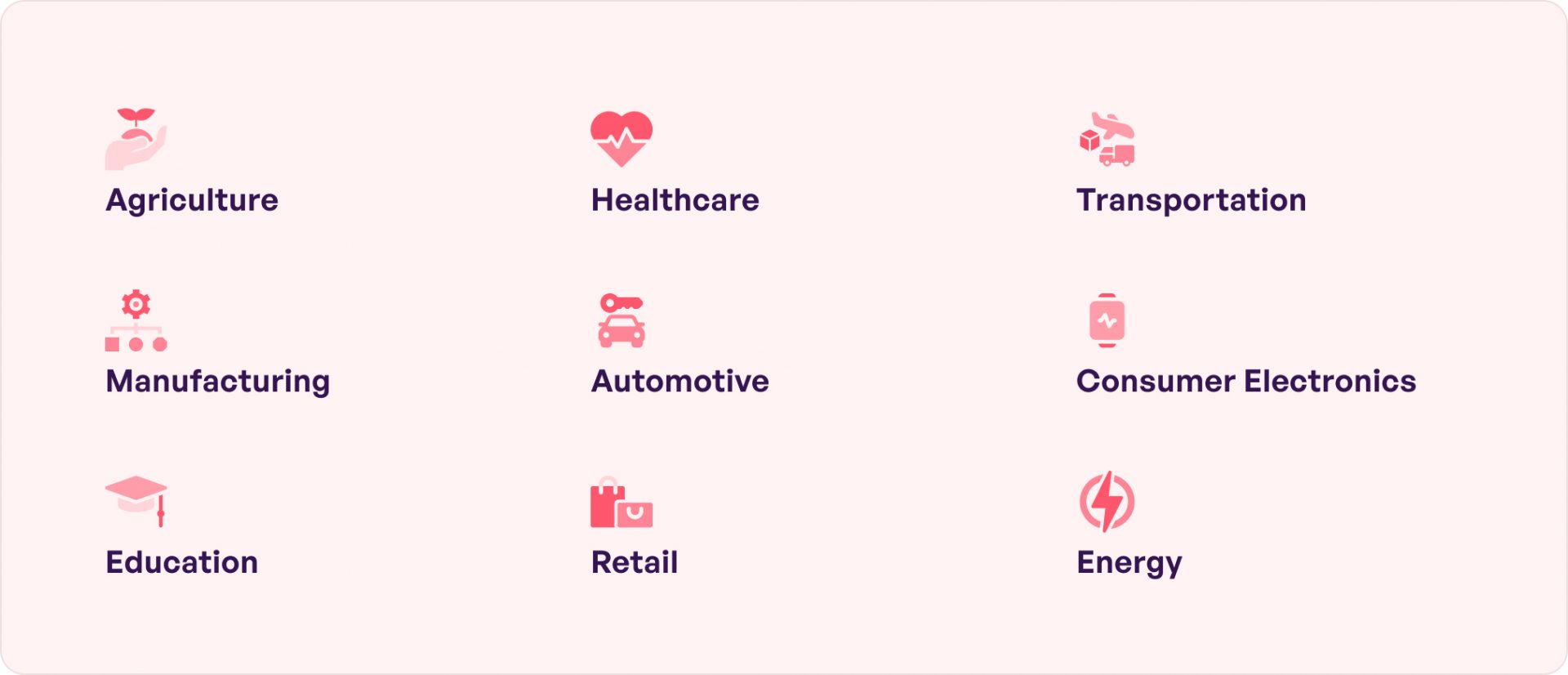
1) Agriculture
Imagine a world where farmers can effortlessly monitor soil conditions, track livestock, and optimize irrigation with just a tap on their smartphones. That’s the power of IoT in agriculture. By harnessing IoT sensors and devices, farmers can boost crop yields, minimize waste, and lower resource consumption. With the global population rising rapidly, embracing smart agriculture is not just a choice, but a necessity for a sustainable future.
2) Healthcare
The healthcare industry is undergoing a transformative shift with the rise of IoT technology. Especially during the recent challenges, IoT applications like telehealth and remote monitoring have surged in demand, enabling real-time patient tracking and streamlined communication with healthcare providers. From wearable devices for personal health tracking to sophisticated hardware for medical staff and equipment monitoring, IoT is revolutionizing healthcare for improved patient outcomes and enhanced efficiency.
3) Transportation
Imagine a world where every vehicle on the road is connected, communicating seamlessly with each other and with the infrastructure around them. That’s the future of transportation with IoT. From ensuring safer roads by preventing accidents to optimizing fuel usage and maintenance schedules in real time, IoT is revolutionizing the way we move. With IoT, transportation isn’t just about getting from point A to point B—it’s about creating smarter, more efficient journeys for everyone.
4) Manufacturing
In the manufacturing sector, IoT is transforming the way factories operate. With predictive maintenance and real-time asset tracking, production processes become more efficient and downtime is minimized. IoT also promotes collaboration between humans and machines, enhancing safety standards and product quality. Embracing IoT in manufacturing isn’t just about innovation—it’s about creating smarter, safer, and more reliable production environments for the future.
5) Automotive
The automotive industry is embracing IoT with connected cars and smart vehicles leading the charge. As automation and AI advance, autonomous vehicles are becoming a reality, promising safer roads and enhanced user comfort. Predictive maintenance keeps vehicles in top condition, while driver monitoring systems ensure safety by detecting driver behaviors and emotions. Additionally, IoT enables real-time road condition analysis and navigation assistance, making journeys smoother and safer for all. Embrace the future of driving with IoT innovations in automotive technology.
6) Consumer Electronics
Consumer electronics are evolving with IoT integration, offering convenience and efficiency like never before. From smart locks securing homes to AI-driven thermostats adjusting room temperature, IoT devices are revolutionizing daily life. With the ability to control appliances remotely via smartphones and tablets, IoT not only enhances convenience but also saves money by optimizing energy usage. As the trend of connected homes continues to grow, the future of consumer electronics looks promising and interconnected.
7) Education
The integration of IoT in education is reshaping the learning experience. From improved communication and collaboration between teachers and students to personalized learning tailored to individual needs, IoT is revolutionizing classrooms worldwide. With enhanced engagement, resource management, safety, and efficiency, IoT ensures a dynamic and effective learning environment. Embrace the future of education with IoT, unlocking endless possibilities for student success and academic excellence.
8) Retail
IoT is reshaping the retail landscape, offering enhanced customer experiences and operational efficiency. From real-time inventory management to personalized sales analysis, IoT solutions empower retailers to meet evolving consumer demands. With features like loss prevention, supply chain optimization, and store automation, businesses can streamline operations and boost profitability. Embrace IoT in retail to create smarter, more engaging shopping experiences that drive success and customer satisfaction.
9) Energy
The energy sector is transforming with IoT, offering enhanced efficiency and sustainability. IoT enables real-time monitoring and optimization of processes, leading to reduced resource utilization and improved consistency. Advanced analytics empower businesses to make informed decisions, optimize generation, and manage demand effectively. With IoT, new opportunities emerge, encouraging growth and productivity through smart technologies. Intelligent grids and cost-saving measures ensure effective energy management, promoting sustainability for a brighter future.
Conclusion
In conclusion, the future of IoT is bright and promising, with emerging trends shaping various industries in profound ways. From the integration of AI and ML for intelligent systems to the expansion of 5G connectivity and the enhancement of security through blockchain, IoT continues to revolutionize technology.
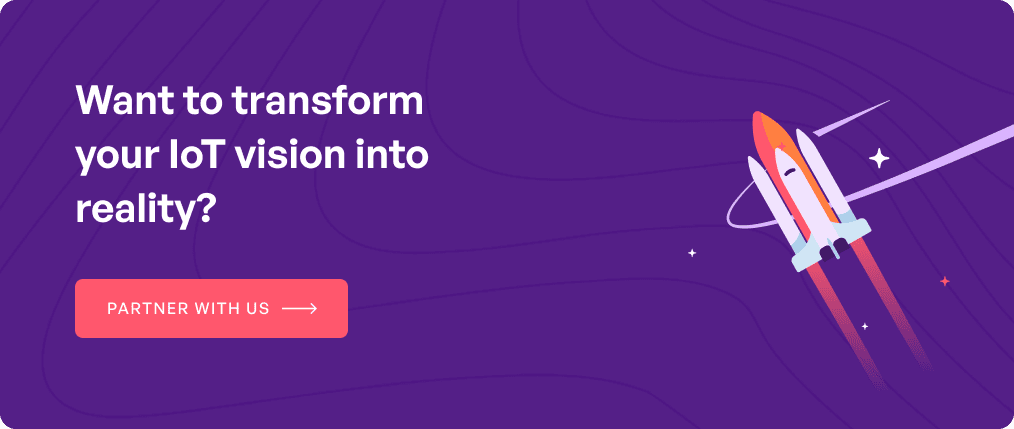 As businesses and consumers embrace interconnected devices, the journey towards smarter, more efficient solutions accelerates. With a focus on data privacy, personalized experiences, and sustainability, IoT promises a future where technology enriches lives and drives progress. Embrace the possibilities of IoT and commence on a journey with us towards a more connected and prosperous future.
As businesses and consumers embrace interconnected devices, the journey towards smarter, more efficient solutions accelerates. With a focus on data privacy, personalized experiences, and sustainability, IoT promises a future where technology enriches lives and drives progress. Embrace the possibilities of IoT and commence on a journey with us towards a more connected and prosperous future.
FAQs of Top IoT Trends in 2024 and What IoT Holds for the Future
Q. What are the main IoT technologies?
Ans. The main IoT technologies include sensors, actuators, connectivity options like Wi-Fi and Bluetooth, and cloud platforms for data storage and analysis.
Q. What is the future application of IoT?
Ans. The future applications of IoT are vast, including smart cities, healthcare monitoring, industrial automation, agriculture optimization, and more.
Q. How does IoT work?
Ans. IoT works by connecting devices to the internet, allowing them to collect and exchange data. This data can then be analyzed to provide insights, automate processes, and improve efficiency.
Q. What are the key technologies driving the Internet of Things (IoT)?
Ans. Key technologies driving IoT include wireless communication protocols like MQTT and CoAP, edge computing, artificial intelligence, and blockchain for secure data exchange.
Q. What are the future trends in IoT security?
Ans. Future trends in IoT security include the use of advanced encryption methods, blockchain for secure transactions, AI-powered threat detection, and improved device authentication protocols.


